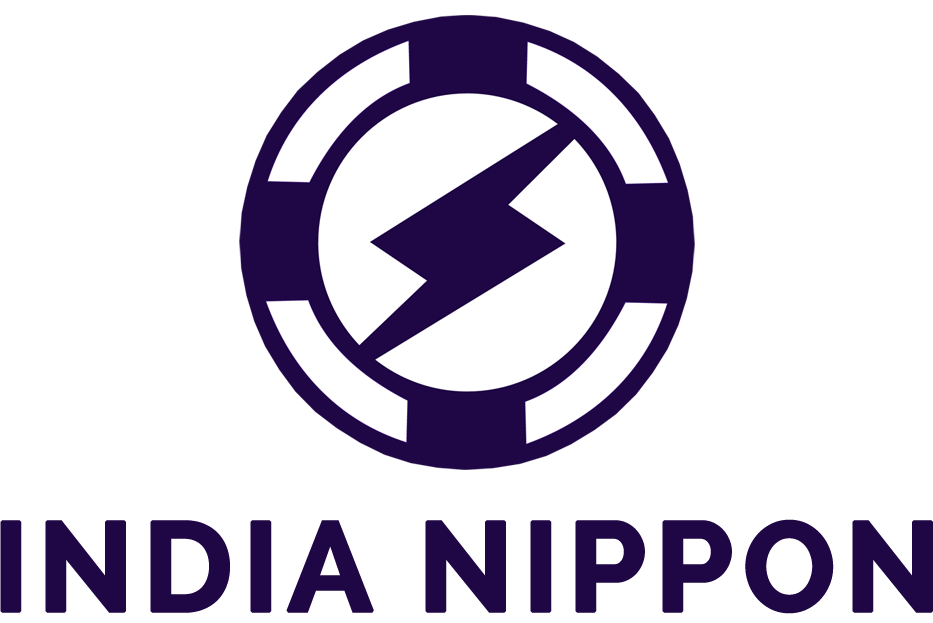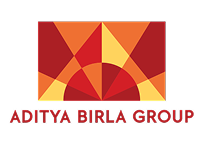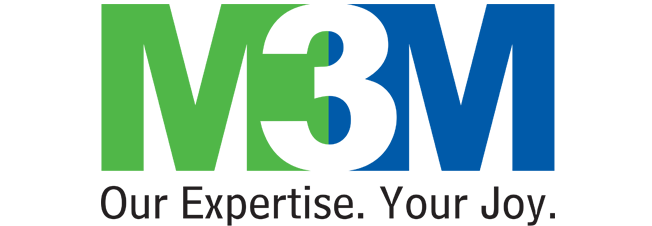Procol • October 10, 2025
Guide to conduct successful procurement audit in 2025
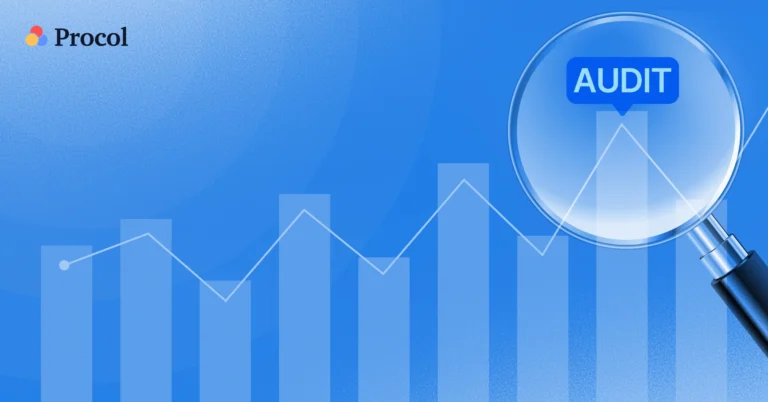
If you get effective procurement right, you save money, stay compliant, and keep suppliers happy.
You get it wrong, and you’re dealing with rising costs, compliance issues, and strained vendor relationships. One of the best ways to keep procurement running smoothly is to conduct a procurement audit. It’s about finding problems, it’s about spotting gaps, tightening controls, and making sure every purchase actually adds value. Done regularly, it can reduce risks, cut inefficiencies, and bring much-needed transparency into the way your organization buys.
What is procurement audit?
A procurement audit is a systematic evaluation of the way an organization procures goods and services with the goal of determining adherence to internal policies, industrial regulations, and ethical practices. A procurement audit review will evaluate documents, transactions, supplier relationships, and internal controls to establish efficiency, fairness, and value for money. Beyond detecting risks or irregularities, it also strengthens governance, enhances transparency, and supports better decision-making. Done effectively, it not only safeguards resources but also drives long-term improvements in procurement performance.
What are the types of procurement audits?
These aren’t all built the same. Some zoom in on compliance, others hunt for risks, and a few dig into performance or day-to-day operations. Each serves a different purpose, and knowing the difference helps you choose the right one for your situation.
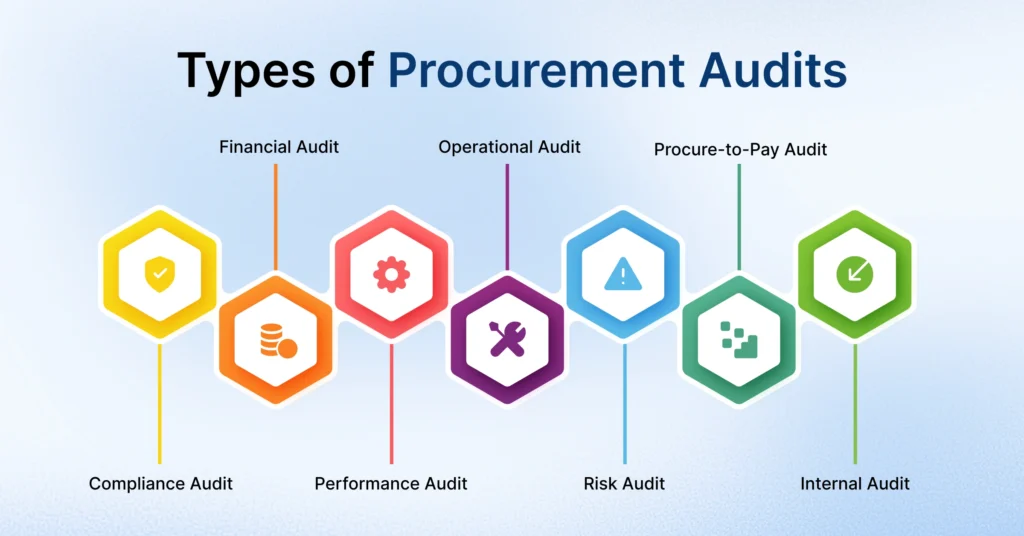
The main types that you’ll come across:
| Type | Description |
|---|---|
| Compliance audit | Checks if you’re following your own procurement policies, legal requirements, and industry rules. |
| Financial audit | Make sure the numbers add up and procurement-related transactions are accurate and complete. |
| Performance audit | Look at efficiency, effectiveness, and whether you’re getting good value for money. |
| Operational audit | Reviews day-to-day procurement activities and internal controls to ensure everything runs smoothly. |
| Risk audit | Identifies threats like fraud, supplier failure, or unstable markets before they hit. |
| Procure-to-pay audit | Follows the entire journey from requisition to payment, spotting process gaps along the way. |
| Internal audit procurement | Regular in-house checks to ensure ongoing compliance and risk control. |
Each type has its own purpose, but together they create a complete picture of your procurement health.
What is the process of implementing a procurement audit?
It works best when it’s done methodically. It’s not about randomly checking a few files, it’s about covering every corner of the procurement cycle so nothing slips through the cracks.
Here’s how it usually plays out:
1. Plan the audit
Start with a clear purpose, whether it’s checking compliance, identifying fraud, or evaluating performance. Define the scope, set the criteria, and establish timelines. Involve the right people and focus on high-risk areas highlighted by past issues or current business priorities.
2. Collect the data
This is detective work. Gather all the pertinent documents, purchase orders, supplier agreements, travel vouchers, approval records, and past audit reports. The more precise and comprehensive your data, the simpler it will be to identify what’s going well and what isn’t.
3. Evaluate the risks
Search for possible trouble spots: non-compliance, fraudulent trends, and over-reliance on a single supplier. Determine where to put your effort depending on the risk factor.
4. Fieldwork and testing
Evaluate sample transactions, review contract compliance, conduct interviews with staff, and observe the process. You are not just checking boxes, you are uncovering how things actually work on the ground.
5. Analyze the results
Compare what is currently happening to what should be happening. Compare it to policy, principles, regulations, and industry best practices. Identify inefficiencies, risks, and missed opportunities.
6. Report back
Focus on making your report clear and usable. State the purpose and scope of the audit, your key findings, areas of risk, and most importantly, your recommendations. State desired next steps, not just general advice.
7. Follow up
An audit is useless if it doesn’t result in action. Follow up to ensure that the recommendations result in implementation. If need be, conduct a follow-up audit to actually monitor progress.
Quick checklist
A procurement audit checklist provides a structured way to review policies, contracts, transactions, and internal controls. It helps identify gaps, improve efficiency, ensure compliance, and strengthen governance, making procurement more transparent and effective. Here is a quick checklist to keep your audit sharp and straightforward:

1. Policies & compliance
It includes checking if the organization has up-to-date, clear, and compliant policies that follow legislative regulations and industry best practices for procurement, and if those policies are applied in a consistent manner across different departments, so that every purchasing decision within the organization is consistently fair and accountable.
2. Supplier selection & contracts
The second element of procurement is checking the selection of suppliers and determining how suppliers are selected to ensure the selection process is fair and competitive. This section also checks if suppliers have made contracts that are clear, inclusive of terms, deliverables, penalties, and if the supplier’s performance is being monitored and recorded.
3. Transactions & payments
Another significant area is verifying the accuracy and authorization of purchase orders, invoices, and payment files. The audit reviews whether there are safe, accurate, and traceable records, while spotting any inconsistencies or potential red flags for financial risk.
4. Internal controls
Internal controls should be strong to evaluate if responsibilities are appropriately separated, for example, the same individual should not be able to choose suppliers and approve the payment, thus minimizing the risk of conflicts of interest and/or fraud in the buyer cycle.
5. Efficiency & documentation
Finally, the audit looks at whether procurement processes are cost-efficient and streamlined. It also ensures that records are complete, accurate, and well-documented, making them easily available for future audits or compliance reviews.
Why perform a purchasing audit?
It is a strategic tool that enhances financial control, efficiency in operations, and stakeholder confidence. Organizations can examine procurement activity in an organized way before weaknesses become costly challenges, and proactively manage third parties on the supply chain front through auditing. It provides real value by assessing existing levels of compliance, analyzing the spend through the procurement process, and tuning procurement processes to ultimately achieve better results.
Where will you gain value from a purchasing audit?
A purchasing audit adds value by identifying inefficiencies, minimizing unnecessary expenses, and instilling an understanding of policy and regulatory compliance obligations. It enables you to identify areas where you can become more efficient, manage suppliers more effectively, and limit risk. An audit will also provide more visibility into spending habits and purchasing practices and allow you to make more informed decisions to ultimately save costs over time.
- Fraud detection/avoidance
At a minimum, audits can identify fraud investigations, for example, double payments, inflated invoices, kickbacks, and unauthorized purchases, minimizing loss/damage and avoiding bad press and reputational damage.
- Compliance
An audit will provide the organization with assurance that procurement processes abide by laws, industry regulations, and internal policies, supporting accountability and transparency.
- Value for money
Audits will lead to improvements in the accuracy of spending, as well as identify waste, find overpayments, negotiate better conditions with suppliers, and learn other financial tricks of the trade.
- Process improvement
Audits assist in identifying blockers and delays, provide documentation of unnecessary process steps, and present hard data on procurement processes to better enable the expediency of procurement processes.
- Supplier-related analytics
Company purchasing audits allow organizations to assess supplier performance holistically, address quality concerns, and maintain performance-driven relationships.
- Transparency & accountability
Audits improve internal controls, provide transparent records of purchasing decisions, and bolster an equitable, ethical, and accountable organizational culture.
A purchasing audit does not simply expose issues; it offers opportunities for improved decision-making and long-term development. It builds stakeholder confidence, protects financial resources, and establishes the foundation for continuous improvement. As organizations find themselves competing in bidding environments, their prospects for stretching budgetary resources, not being penalized for non-compliance, and becoming increasingly responsive give them an edge in both operational and strategic performance.
How to conduct a procurement audit (steps)
A structured approach is a key to ensuring the assessment is both thorough and meaningful. It gives organizations an opportunity to identify weaknesses, enhance processes, and formalize system controls. The following stepwise guide provides a structured road map to execute this assessment.

Step 1: Establish objectives and scope of the audit
Clearly articulate the aims of the audit, whether it is to assess compliance, identify fraud, evaluate performance, or review risk control. Establish the audit scope, including which departments, contracts, or procurement cycles will be audited.
Step 2: Preparing the Audit Plan for Procurement
Set the time frame for the audit, materials required for it, data to be gathered and audit methods to be employed, and procurement personnel and stakeholders to be engaged in the audit.
Step 3: Collect and Review Documents
Collect all relevant procurement documents, such as requisitions, supplier contracts, purchase orders, invoices, and approval logs. Review the policies and procedures, as well as any reports that may have been done previously.
Step 4: Fieldwork and Testing
Sample transactions and test controls. Interview procurement personnel and vendors to understand the processes and identify vulnerabilities.
Step 5: Analyzing the Audit Findings
Decide how far the actual practices deviate from the policies and best practices. Identify gaps in compliance, risks, and inefficiencies. Quantify any financial impacts where possible.
Step 6: Draft the Report
Once completed, share the draft report with management for review and feedback. Working on the draft as a group leads to good transparency, gives stakeholders an opportunity to clarify any findings, and lets the organization determine if the recommendations align with its business aims. Engaging in open discussions in this part of the process creates transparency and helps to create accountability in implementing actions, and increases the likelihood of carrying out the suggested improvements.
The end of the assessment is not the end of the process; the final part of the process is how the organization will focus on solutions and changes that will impact the organization. By using a framework to assess how the right people were involved at each stage, the organization has an opportunity to enhance compliance, efficiency, or effectiveness, or reduce risk to the organization. Ultimately, a well-managed auditing process can also facilitate a transition by providing insights into how to implement a path to meaningful change that can create long-lasting value.
What are the purposes of a procurement audit?
This should not be seen as a simple exercise; it is a formal assessment that is conducted to reflect on the purchasing process to ensure purchasing is happening effectively, following compliance protocols, and is aligned with the strategic direction of the organization. By being clear with its objectives, organizations can target their audits in a way that produces a measurable improvement in performance, better cost containment, and better supplier relations. Clarity on the purpose of objectives allows auditors to be consistent, clear, and accurate during the review process.
Ensure compliance
The most significant objective is to ensure that all procurement activities comply with applicable laws and regulations and with the organization’s internal policies. The audit process helps minimize the risk of legal disputes, regulatory penalties, reputational damage, and the loss of support from the stakeholders of the organization.
Establish transparency and accountability
Audits provide the opportunity to clearly document every aspect of the purchasing decision, to verify that approvals are present, and to follow the procurement activities being made. As a result, there will be a culture of ethical behavior, accountability, and responsible use of resources.
Identify risks and reduce them
It allows us to identify the organization’s weaknesses, for example, an unauthorized transaction, reliance on a small pool of suppliers, poor contractual terms, or inadequate performance, and take preventative action on disclosed vulnerabilities.
Improve costs and value
Audits help assess cost effectiveness, ensuring that every purchase provides the best possible value for money without loss of quality or service standards.
Enhance process efficiencies
Audits identify delays, redundancy, and deficiencies in controls for procurement processes and help to seek a way to achieve quicker timelines for better efficiency and less administrative burden.
Facilitate strategic procurement goals
Procurement is increasingly no longer just a transactional function; it is strategic. Audits help to ensure procurement activities align with organizational priorities like sustainability, innovation, and supplier diversity.
The objectives are not solely targeting errors; they set the framework for continued improvement. By confirming the degree of compliance, exposure of efficiencies, and alignment of procurement objectives to long-term goals, it also serves as a starting point for operational excellence. Organizations that use audits for their stated objectives and as a tool for intentional learning can help to enhance the procurement role as a source of competitive advantage, instead of merely administrative support. instead of merely administrative support.
What are the key stages of the procurement audit process?
A procurement audit is a systematic review to assist organizations in evaluating the effectiveness, efficiency, and compliance of their procurement processes. The goal of this process is to ensure the organization’s procurement in accordance with policy, regulation, and the organization’s objectives. Additionally, an audit can provide insight into risks and opportunities for improvement. The procurement audit process typically contains a number of stages that, together, provide a methodical process.
| Title | Description |
| Pre-audit planning | Determine scope, objectives, and focus of risks. Gather baseline data/gather or create audit tools. |
| Fieldwork execution | Test procurement transactions, observe processes, and gather evidence through interviews and review of existing documentation. |
| Data analysis phase | Assess findings against organizational policies and industry benchmarks. Identify gaps and enhancement opportunities. |
| Completion of audit report | Completion of the audit report |
| Management review and action | Talk through your process and corrective actions with other key personnel. |
| Report and communication | Communicate the comprehensive final audit report to all relevant parties. |
| Follow-up | Follow the uptake of recommendations and collect follow-up audits as needed. |
Best practices for procurement audit
Conducting a procurement audit successfully requires more than just an audit of documents; it requires a systematic approach, inter-departmental collaboration, and contemporary tools. Adhering to best practices will not only improve the precision of the audit but, just as important, ensure that the findings link to positive enhancement in procurement performance. Best practices are the critical model that organizations should internalize into each cycle of auditing so that organizations can evolve from a reactive, problem-solving mode into a proactive, process improvement mode.
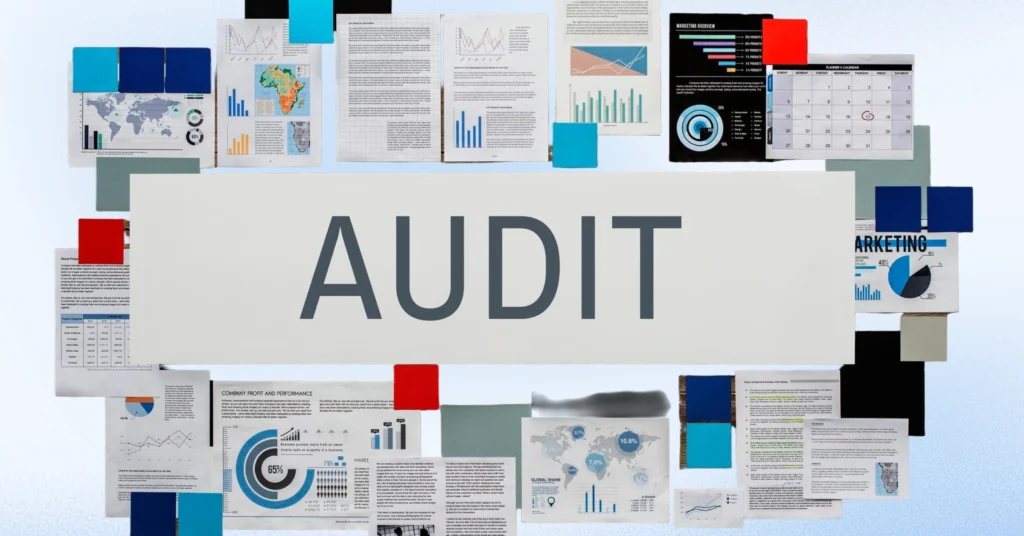
Cross-functional teams
Involve personnel with various specialities or departments, which could include procurement, finance, legal, and operations. By involving representatives from multiple functions, you can ensure that the audit has covered all the relevant perspectives, as well as the real-world operational aspects.
Make use of technology
Rely on technology, data analytics, automated reporting, audit tools, and software to identify anomalies, trends, and patterns more effectively than just reviewing numerous hard copy documents.
Be transparent
Create a culture of transparency, demonstrate openness during the audit where you can report the findings in a positive way to establish trust, promote cooperation, and strengthen positive relationships among stakeholders.
Demonstrate transparency
Keep the audit steps open and communicate findings in a constructive manner so that relationships between stakeholders are built on trust and provide an opportunity to collaborate.
Customize the audit scope
With respect to procurement, you will want to focus on audit areas that pose the highest risk or provide high value, and be flexible with changing the audit scope as necessary with changing needs and market conditions.
Continuous training
Training and training against both auditors and procurement teams regarding compliance requirements, audit standards, and internal policy to tackle new potential market or regulatory risks.
Benchmarking
Comparing procurement practice and performance with industry best practices and peers will highlight competitive gaps in practice and opportunities to improve.
Complete documentation
Complete documentation of audit steps, including supporting evidence, covers communications to establish accuracy and accountability.
These practices lead to deeper analysis, quicker resolutions, and long-term continuous improvement that can be built into processes. We can develop a stronger procurement function that is not only compliant but also strategically aligned for delivering value. Organizations that leverage technology in procurement and collaboration, and a structured, clear audit framework, are in a better place for efficiencies, cost management, and supplier oversight in procurement.
Conclusion
Creating an effective program is crucial for organizations that want to support strong purchasing processes, manage risks, and support compliance. Regular procurement audit delivers valuable insights to eliminate waste, combat fraud, and improve supplier relationships. Transparency and accountability within all procurement activities can be developed when structured audit planning, supported with effective execution and follow-up, is established.
All of these attributes will deliver efficiencies and effectiveness to evaluation processes when organizations wish to be more aware of procure-to-pay processes. Faster visibility and control will provide a quicker and better audit experience, where the strategies and values can be strengthened.
Frequently asked questions
What are a few examples of procurement audit?
Examples include reviewing supplier contract compliance for government projects, auditing purchase order accuracy in manufacturing, assessing competitive bidding in healthcare procurement, and conducting internal audits to detect conflicts of interest in vendor selection.
What is the role of auditors in procurement?
Auditors independently evaluate procurement processes to ensure compliance, assess risks, detect fraud, and recommend improvements, thereby safeguarding organizational resources and enhancing transparency.
Who are the key stakeholders in procurement audit?
Key stakeholders include procurement managers, internal audit teams, finance departments, compliance officers, senior management, and sometimes external auditors or regulators.
What should be included in a procurement audit plan?
A procurement audit plan should specify the audit objectives, scope, methodology, timelines, resource allocation, risk assessment, and data requirements.
How often should you hold a procurement audit?
Frequency depends on organizational risk profiles but typically ranges from annual to biannual audits, with more frequent audits for high-risk procurement categories.
How does a procurement audit help improve vendor management?
By evaluating supplier selection criteria, contract adherence, and performance monitoring, procurement audits identify opportunities to enhance vendor relationships and ensure value for money.
Can procurement audits detect fraud?
Yes, procurement audits can uncover fraudulent activities such as invoice manipulation, unauthorized purchases, or collusion through transaction testing and control assessments.
Explore more from Procol
Discover expert tips, how-to guides, industry insights, and the latest procurement trends.
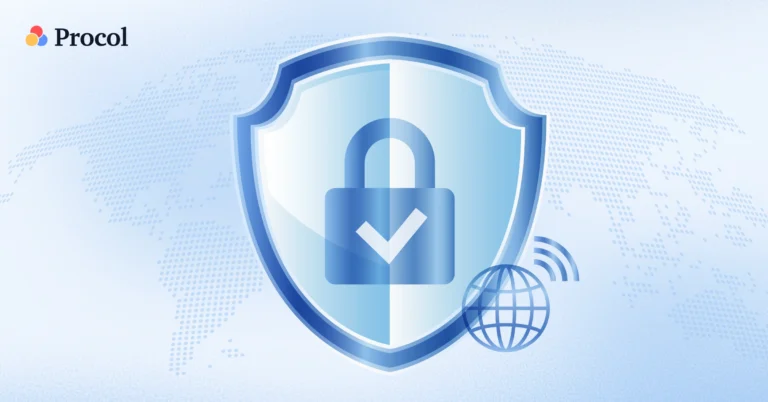
What is supply chain risk management (SCRM)? | Definition & steps
In an increasingly interconnected world, organizations rely on smooth supply chain...
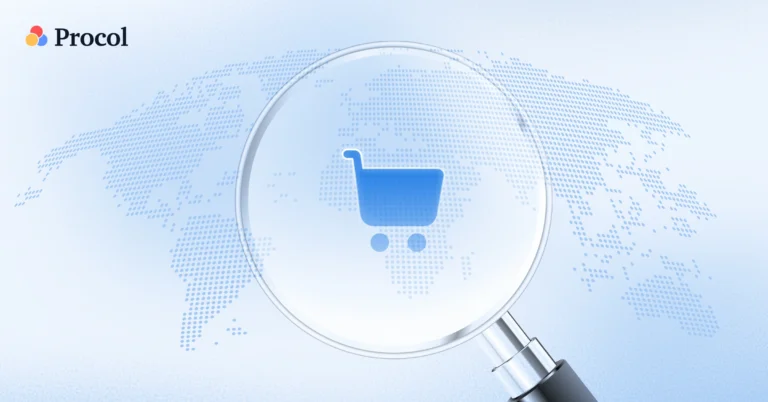
Strategic sourcing management software & sourcing solutions: a guide
Learn how strategic sourcing software helps optimize processes, key features and...
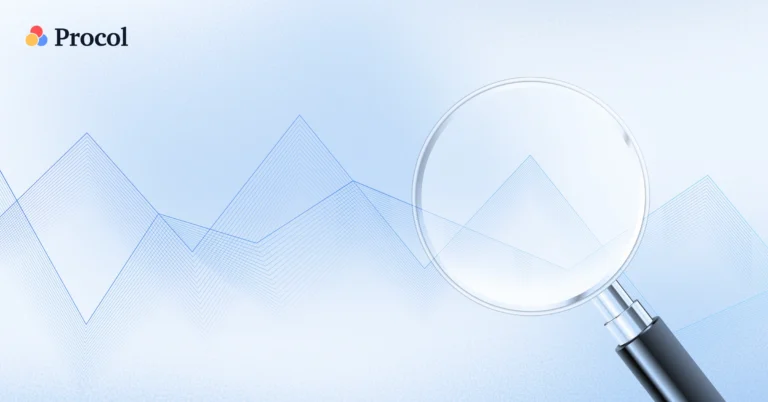
Sourcing strategies explained: Types, process, benefits, and examples
Sourcing strategies are important for creating effective, efficient, and resilient supply...
